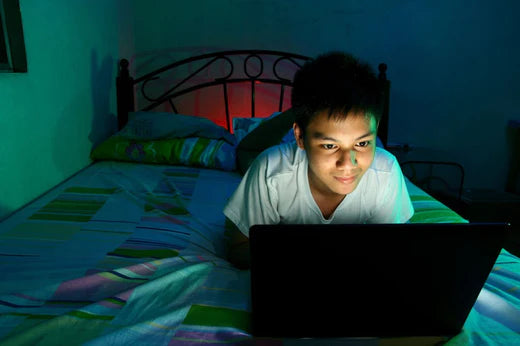The Star Paper: Addressing Computer-Related Eye Strain


Today's prevalent use of computers and mobile devices has resulted in a myriad of afflictions that were considerably rare just 10 years ago, including computer vision syndrome (CVS).
Today's prevalent use of computers and mobile devices has resulted in a myriad of afflictions that were considerably rare just 10 years ago.
One of these problems is a common one, and that is computer vision syndrome (CVS).
This problem describes a group of eye- and vision-related problems from prolonged gadget use, such as computers, tablets, and mobile phone use.
Also known as digital eye strain, CVS symptoms include complaints of headaches, blurred vision, back pain, fatigue, eyestrain, and a broad range of non-specific effects. These include dry eyes, double vision, difficulty in visual focusing, and dizziness.
According to ophthalmologist Dr Leow Sue Ngein, CVS occurs when ciliary muscles, which control the lens in the eye when focusing, are unable to recover from the constant tension to maintain focus on an object up close.
“When that happens the ciliary muscles can sometimes go into spasms, a condition called accommodation spasms, or ciliary spasms,” said Dr Leow.
She pointed out that an average person usually spends seven hours a day at the computer at work.
However with the movement control order during the Covid-19 pandemic, these hours could stretch to 11 hours when people work from home.
CVS is then aggravated by the home’s improper lighting conditions and the presence of glare. Air movements can also cause dry eyes and unlike working in the office, viewing distances and sitting posture at home may not be proper.
So people end up with backaches or other ailments such as muscle spasms, shoulder aches, neck pain and more.
CVS can also be caused by convergence insufficiency, whereby the person’s ciliary muscles aren’t strong enough to shape the lens to produce clear images.
Refractive errors such as farsightedness and astigmatism could worsen CVS.
Blue light effects

Ophthalmologist Dr Leow Sue Ngein said children are more susceptible to CVS as they have a limited degree of self-awareness.
One of the more insidious factors of CVS that is generated by computer monitors and mobile devices is blue light.
This portion of the light spectrum wavelength ranges from 380 to 500 nanometers and is present in sunlight and man-made indoor sources, such as fluorescent and LED lights to digital devices like smartphones and tablets.
It is more energetic and can cause more damage by hastening macular degeneration – a condition that occurs in old age whereby the centre of one’s field of vision is blurred or there’s none at all.
It can develop faster when exposed to too much blue light as blue light causes cells in the retina to lose sensitivity hence the blurred or blind centre spot.
“The question is,” Dr Leow posed, “how much is too much?”
Despite its bad rep, blue light actually does have benefits for living beings; in fact, it is actually important for good health.
“Research shows that high energy visible light boosts alertness, helps memory and cognitive function, and also elevates mood,” said Dr Leow.
“Some people are given light therapy to treat seasonal perceptive disorder, which is actually more prevalent in more temperate to cold climates where gloom and darkness extends longer during winter months.”
Blue light also helps regulate the body's circadian rhythms – which is our own natural body clock that regulates wakefulness and sleep cycles during the day. “But when we are exposed to too much during the night, that can affect our sleep patterns, causing insomnia and other problems,” Dr Leow cautioned.
While there is no experiment or research that shows how much direct blue light is harmful to the eyes, experiments done on animals (1) indicated that prolonged exposure to high levels does cause macular damage.
But Dr Leow said humans would not have exposed themselves to the levels used in the experiments.
“However, the concern is that excessive blue light exposure due to increased gadget use will increase macular degeneration risk later on in life.”
Children’s needs
Children however need special attention, said Dr Leow, as they are more susceptible to CVS.
“Children have a limited degree of self-awareness and they become engrossed on the computer or with mobile devices for long hours without taking breaks in between, until they are really tired.”
Such behaviour can cause accommodative spasms and eye irritation. In addition, they don't blink often when concentrating on the screen, causing poor tear distribution and contributing to dry eyes.
Children’s adaptability to their environment also makes them ignore or fail to recognise a problem.
“They will continue to watch a computer screen with a lot of glare without thinking of adjusting the screen or their surroundings to alleviate the problem,” Dr Leow said.
“Sometimes they accept their blurred vision as normal because they think everyone sees the same way too.”
Dr Leow advised that children should have a general eye test at the age of three, and before they begin their formal education, when they are about five to six years old.
Subsequently, they should then be checked every two years to detect any refractive error or convergence insufficiency (where the muscles are not strong enough for accommodation).
Parents should also reduce the amount of times the children spend on a computer continuously.
While adults using the computer can adopt the 20-20-20 rule – whereby in every 20 minutes, they should focus 20 feet away for 20 secs – children should break from continuous electronic device use for 10 minutes every hour.
“Parents should also check that the computer screen, keyboard and seating height are adjusted to the child's body parameters to promote good body posture,” added Dr Leow.
They also need to check ambient lighting and eliminate glare from the computer screen.
Dr Leow recommended limiting the use of mobile devices, such as tablets, to about an hour a day, especially for preschoolers aged two to five (2).
Time spent on educational activities might not need to be as restricted as time spent on playing computer games.
Parents can help to monitor how their children or teens use screens. The naturally red carotenoid found in the Haematococcus pluvialis microalgae called astaxanthin is a strong antioxidant.

The naturally red carotenoid found in the Haematococcus pluvialis microalgae called astaxanthin is a strong antioxidant.
Eye protection
Dr Leow recommended that one way to maintain healthy eyes is by consuming a good form of antioxidants, which prevent inflammation from exposure to blue light.
A recent study last year (3) showed that a natural red carotenoid found in microalgae Haematococcus pluvialis called astaxanthin has “the advantage to directly address the main pathogenic factors underlying ocular diseases, such as cumulative oxidative stress and chronic subclinical inflammation.”
It also showed a good safety profile with no adverse events having been reported in any clinical studies.
Dr Leow explained that astaxanthin helps improve the accommodative function of the eyes by controlling the contractility of the ciliary muscles.
It alleviates eye fatigue by reducing cellular inflammation that emerges because of persistent eye stress and contraction of the ciliary muscles.
It also improves capillary blood flow in the retina, which will help improve the eyes’ internal balance, nutrition, oxygenation and waste removal.
Astaxanthin has a strong antioxidant potency – being 6,000 times stronger than vitamin C and 4.9 times stronger than beta carotene (vitamin A) and 2.6 times stronger than lutein.
It is purely an antioxidant molecule so it has broad anti-inflammatory properties and can suppress five inflammatory signalling pathways in the body.
Due to that, astaxanthin protects against all the inflammation experienced in the eyes.
For details, call the toll-free hotline 1-800 881 201 or 010-213 8101, email enquiry@optixanthin.com, or log onto www.optixanthin.com.my
Source:
https://www.thestar.com.my/lifestyle/health/2021/01/10/addressing-computer-related-eye-strain
REFERENCES:
1) Kim, Gyu Hyun et al. “Functional and morphological evaluation of blue light-emitting diode-induced retinal degeneration in mice.” Graefe's archive for clinical and experimental ophthalmology = Albrecht von Graefes Archiv fur klinische und experimentelle Ophthalmologie vol. 254,4 (2016): 705-16. doi:10.1007/s00417-015-3258-x
2) Reuters, T, “WHO Recommends 1-Hour Maximum Screen Time per Day for Kids Younger Than 5 Years”. 25 April 2019, https://gadgets.ndtv.com/mobiles/news/who-recommends-1-hour-maximum-screen-time-per-day-for-kids-younger-than-5-years-2028442
3) Giannaccare, Giuseppe et al. “Clinical Applications of Astaxanthin in the Treatment of Ocular Diseases: Emerging Insights.” Marine drugs vol. 18,5 239. 1 May. 2020, doi:10.3390/md18050239


